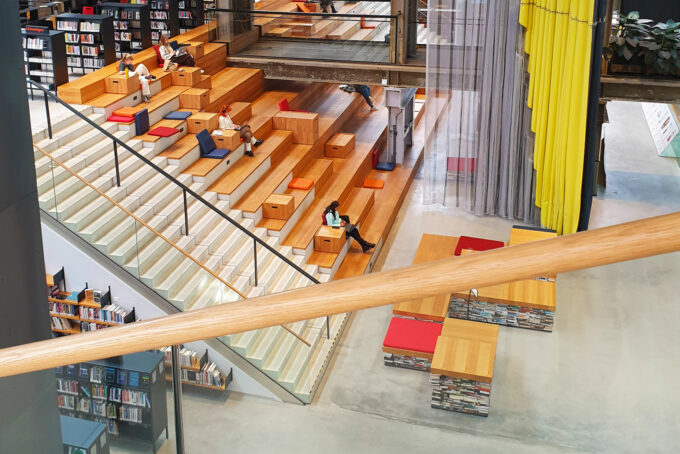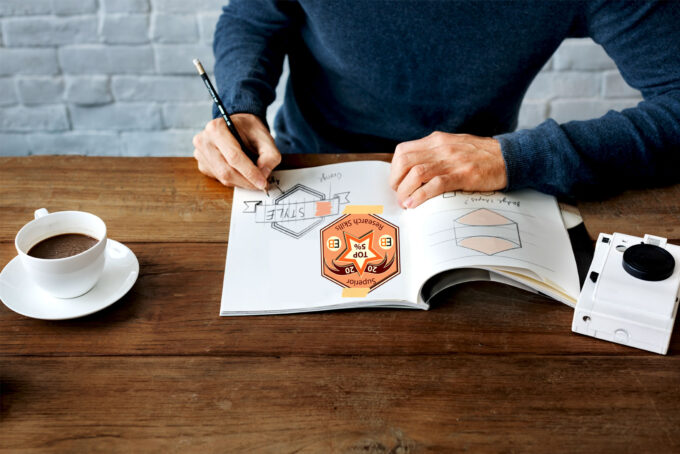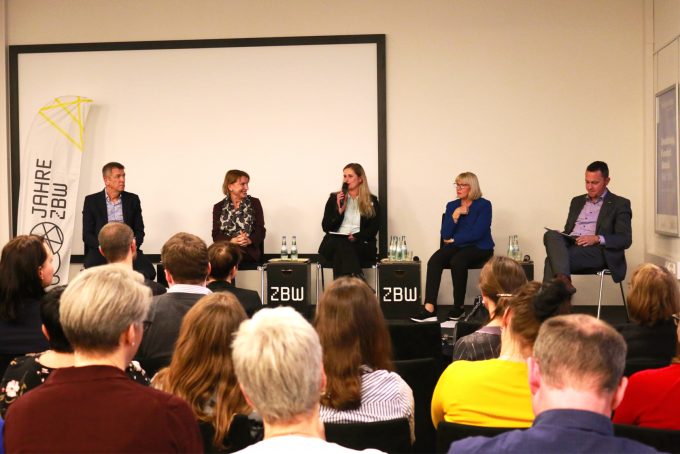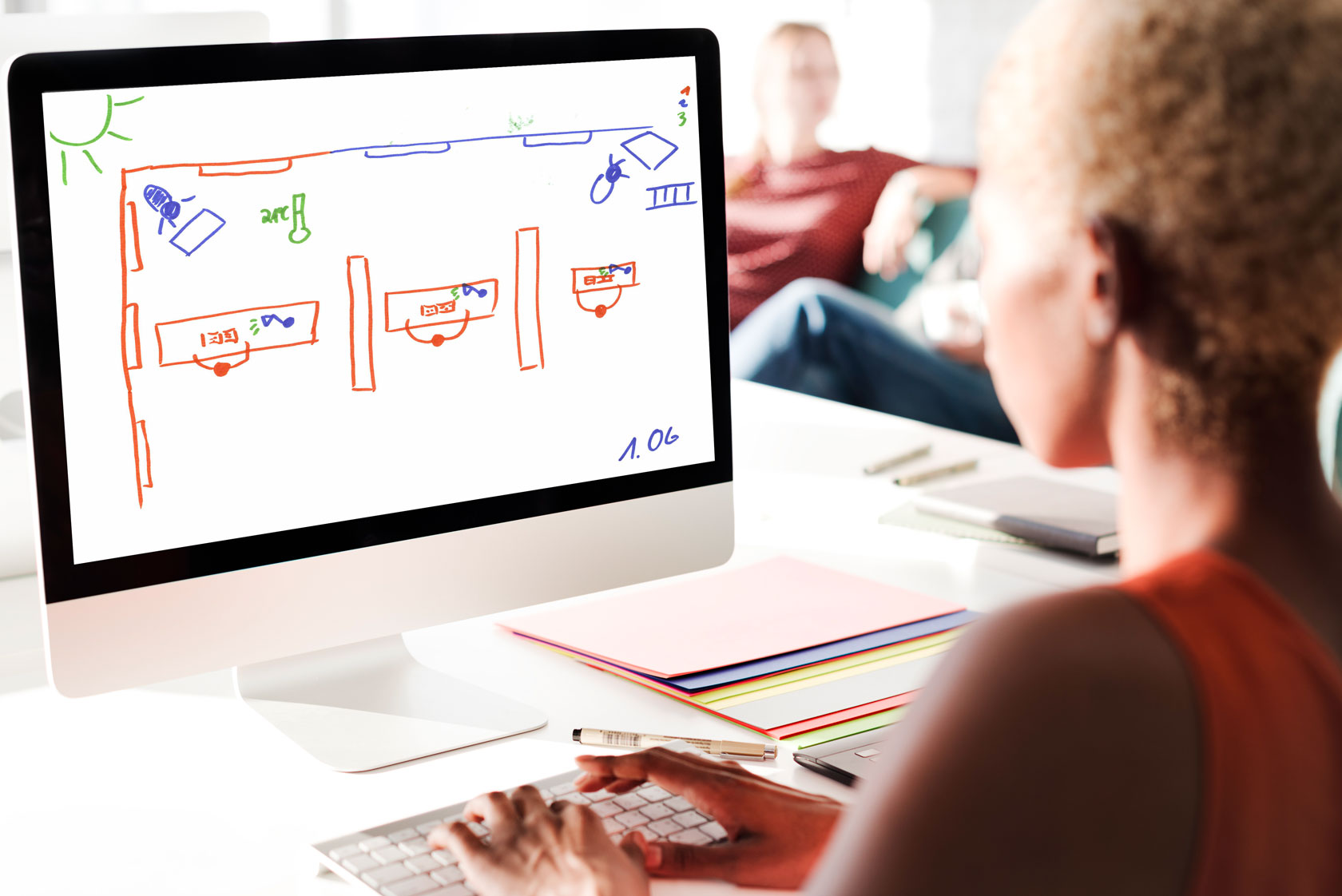
User Experience for Libraries: The Best Tools and Methods for Beginners
Relying on users to discover how products and services can be improved: it’s what the user experience method is all about. It sounds complicated, but is simple at its essence. Today, we’re presenting the best tools and methods for UX beginners in libraries.
by Nicole Clasen

Through practice-oriented surveys, user experience (UX) gives libraries the opportunity to get to know the needs of their users in a completely new way – and (further) develop their own services in a user-oriented manner. Innovative methods are used to harness users’ perspectives, explore their wishes and requirements and have them look at their own facility from a different perspective. UX offers library staff several options to approach this methodically. ZBW employee and UX expert Nicole Clasen presents these options here.
User experience originally comes from software development and considers all the effects that a service or user interface has on the user before, during and after use. When it comes to the user experience of a product or service, the usage process is considered in its entirety. The product should be easy to use, useful for the individual and – in the best case – funny and desirable.
User experience in libraries: fields of application and advantages
Many UX methods are highly versatile. In addition to inspecting discovery systems, library catalogues and websites, they can also be used for engaging in a detailed analysis of information and communication in the library – not to mention its room and building design.
The advantage of UX methods is that, together with their users, libraries consciously consider their perspective and focus on users’ actual activities. The methods are also suitable in serving as an uncomplicated and inexpensive introduction to user research and ethnography. Ethnography (German) comprises the empirical summarization and interpretation of impressions during a participant-based observation. UX enables libraries to identify the (un)conscious wishes of their users and implement them in their services. This leads to better – and ideally, more intuitive – usable services and products. Libraries thus save development time, receive fewer support questions and can better divide their staff capacities between other services and tasks.
The two major fields in user experience research
According to Schmidt, Etches (Schmidt, Etches (2014). Useful, Useable, Desirable), UX methods can be divided into two topics: attitudinal research methods and behavioural research methods.
- Attitudinal research methods: Attitudinal research methods intend to find out what users think and say. Common attitudinal methods include interviews, cognitive mapping, love & breakup letters and graffiti walls.
- UX methods from behavioural research: Behavioural research methods focus on the actual activities and behaviour of users. The stated, perceived behaviour and the actual behaviour may well differ in practice. Here, common methods include observation, behavioural mapping, touchstone tours and usability testing.
UX methods for libraries
I would now like to present a selection of the methods that are particularly suitable for libraries as an introduction to user experience.
Behavioural mapping: studying pathways
Das Behavioural Mapping (PDF) is an extension of pure observation. It focuses on users’ pathways and is well suited to serve as an introduction to UX methods. All you need is a floor plan or self-sketched plan of the room or library floor you want to study, as well as writing instruments. Then sit in this room for a certain time and observe the users.
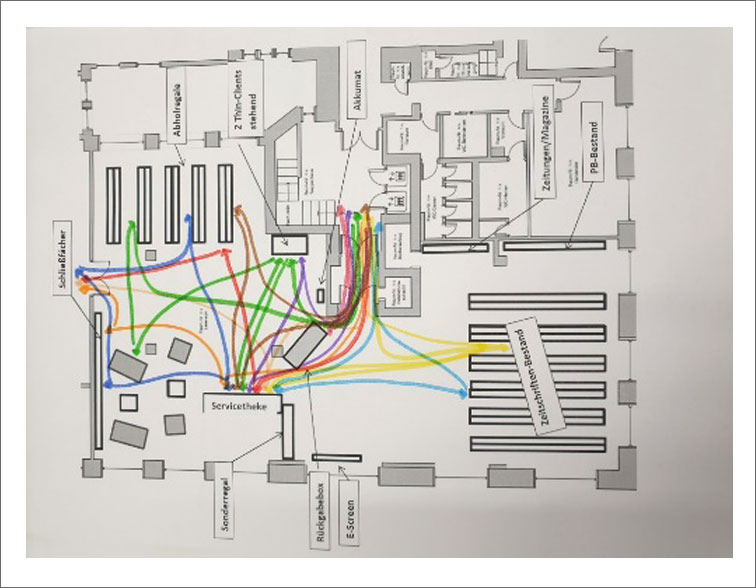
Where are they going? Which way do they go? In going these directions, which offers are bypassed? For each person, you document the pathway and stations on the plan. Ideally, you should repeat this test at different times over the course of several days. This will allow you to form a better image of the habits involved.
Love & breakup letters: Dear coffee machine…
With the „Love & Breakup letters“ method (PDF), you ask your users to write a letter directly to a product or service. Why do they love and use this product? Why do they look forward to using it every week or every day? Or in the case of a breakup letter: What do they dislike about this product? Why is the product so bad – or why are they so annoyed by it – that they would prefer not to come to the library at all? It would be a pity if, for example, the coffee from the vending machine is so tasteless that nobody wants to use the corner lounge. This method can be carried out in groups or individually – and can be associated with the graffiti walls, for example.
Graffiti walls: oversized pinboard
With the graffiti wall, you give your users a free-flowing space to express ideas or wishes. It’s an oversized pinboard that anyone can use. Either with respect to general topics like “What’s missing in this library?” and “What’s your favourite place?” or with changing questions like the topic of the month. Using large packing paper, graffiti walls can be set up on a wall, on a metaplan wall or something similar. Place them in a busy spot in your library: before you know it, they’ll be full of inspiring ideas. These can also be reused or discussed on social media channels.
Cognitive mapping: user research for advanced users
Cognitive Mapping (PDF) is a more sophisticated method, especially in terms of persuasiveness. With this method, users are allowed to draw! And when the term “drawing” comes up, the number of volunteers suddenly becomes manageable. For six minutes, users draw a rough sketch on a specific question such as “What does your ideal learning location look like?”
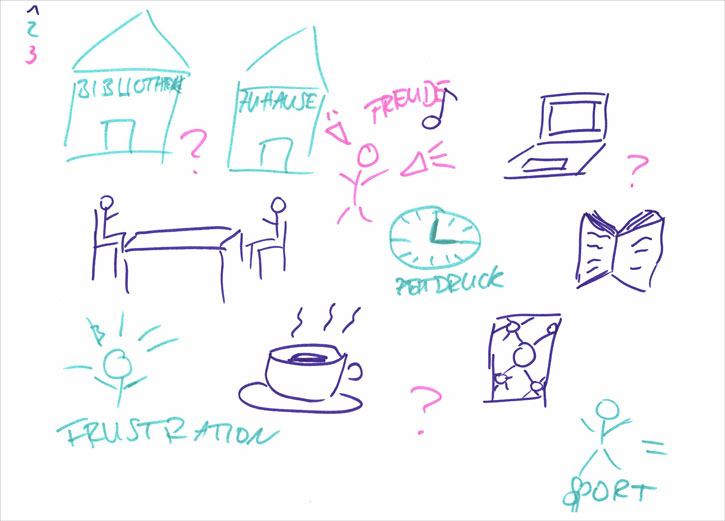
Drawing addresses different areas of the brain than speaking, so the results of this method often differ. The six minutes of drawing are divided into two minutes each for three different colours. Which colours are chosen is unimportant; the most exciting details often only arise with the last colour.
User journey mapping: visualised user experience
With the aid of this method, you and your users work out a complete process sequence such as an enquiry. The users plan the process and describe how it plays out. Typical questions include: How do they perform this task? How do they feel about it? What are they thinking during the process?
Upon completion of the user journey mapping, you have a visual representation of the entire user experience in connection with the task at hand. You can also carry out this method on your own and orient yourself with previously defined personas (user models). However, it’s worth noting that implementation with real users offers greater added value.
Touchstone tours: on the trail of users
Touchstone Tours (PDF) help you to consciously see your library through the eyes of your users. This is made possible by having your users guide you through your library, showing you how they perceive and use it. What is their daily routine? What do they use in the library – and in what order? What is not used or observed at all? The terms used by users for service x and y are also exciting. This method makes in-depth exchange about the library’s services possible. It can also be combined with a small selection of brief interview questions.
Motivating to participate: but how?
Would you like to try out UX and are now asking yourself how you can convince your users? Then get the promotional gears in motion. Via your channels, report on the planned initiative – and later, of course, on the results and implementation.
In practice, a friendly introduction, a good and simple explanation of the method and a small reward like wine gums are usually all it takes to find enough participants for a test. Your users will be pleased that you are interested in their wishes and experiences, and that you want to make a difference together with them. You can also start with observations: these only require passive user participation and facilitate a starting point to the subject matter.
UX method application in libraries: conclusion
The tools and methods presented here are only individual puzzle pieces from the large overall picture of user experience research. Many of them are expandable, can be supported by pure usability methods or professionalised through technical solutions. Whatever the case, getting started with UX is very simple for libraries.
“Just try it out” is therefore a good motto to apply to achieve small but effective results. After all, even small changes signal to users that you want to improve your library – and that their input and needs play a major role in this.
A library can usually do more than users do expect. UX methods can help to harmonise basic user needs with library services. It is also helpful to take a close look at which services are not used or addressed. Maybe the opportunity to tidy things up will arise?
This might also interest you:
- In the article “User Experience in Libraries: 4 Best Practice Examples from the ZBW” I present some examples from our work with UX.
- Podcast with Nicole Clasen: Experience the digital library (German).
- User Experience in Libraries: 4 Best Practice Examples from the ZBW.
- User Experience in Libraries: Insights from the Library of the University of Amsterdam.
- Libraries as a Place after Corona: Hybrid and Participatory?
- Andy Priestner is a pioneer in the field of UX in European libraries. In addition to workshops and the annual UXLIBS conference his „Andy Priestner Training“ blog offers good information as an introduction to the topic. The Website of Ned Potter also offers a good introduction to UX.
Nicole Clasen is Head of User Services at ZBW – Leibniz Information Centre for Economics. Her work focuses on information transfer, digital user services and the usability experience. LinkedIn and Twitter.
Portrait: ZBW©, photographer Sven Wied
View Comments

Open Science Right from the Start: How the UBC Okanagan Library Introduces Students to Good Scientific Practice
Students have always been catalysts of change. Why not use this characteristic for...

